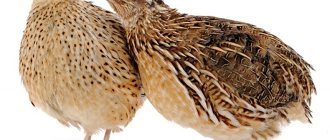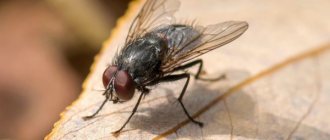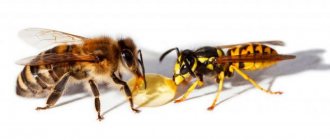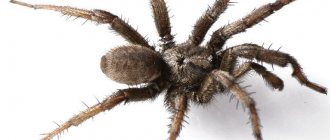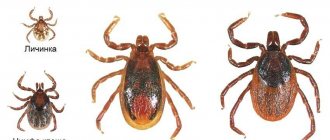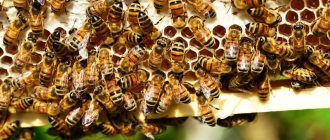Main differences, examples with photos
Males and females of Ternetius are almost the same from each other, so beginners often have difficulty determining the sex of the fish.
There are several signs that can help you successfully distinguish “boys” from “girls.”
Next, we will look at the signs of difference between ordinary Ternetias, using examples with photos, after viewing which it will immediately become clear how to distinguish a female from a male. The considered characteristics are fully applicable to other types of these fish:
- Veil;
- Albinos;
- Caramels;
- Glofish.
Size
One of the main signs: females are almost always larger than males , since in the future they will have to bear eggs.
On the left is a female, on the right is a male.
Often, inexperienced aquarists find it difficult to determine the size of fish through glass. In this case, you need to look at them from above: “girls” look wide, and “boys” look rather narrow.
Color
Males have a brighter color - their body is black, and the stripes have clear boundaries.
In adult individuals, the deep black tail part stands out most strongly. In addition, they have a white edging on the caudal fin.
Females, in turn, look pale , the stripes on their body gradually change color. The caudal fin is transparent.
On the left is a female, on the right is a male.
Behavior
When the spawning period approaches, the males begin to actively chase the females throughout the aquarium. The owner can even arrange a small experiment: raise the water temperature a little and start feeding the fish only with live food.
After a few days, it will become noticeable that some individuals behave aggressively, while others, on the contrary, become passive and allow themselves to be surrounded. This way you can identify “boys” and “girls”.
Anal fin
A wide anal fin resembling a skirt is a distinctive feature of Ternetius, but it is also a sexual characteristic.
In males, the fin gradually tapers from the belly to the tail. In females, in turn, the “skirt” is uniform along the entire length, moreover, it looks wider and more expressive than in “boys”.
Male above, female below.
Other signs of difference
Among other criteria, only the shape of the dorsal fin can be distinguished. In males it sharply sharpens, and in females it smoothly rounds.
Nuances you need to know
In order not to be mistaken in determining the gender of Ternetius, it is important to consider the following factors:
- for comparison, you need to select mature fish;
- Pets should be well cared for, as if poorly cared for they will become lethargic, thin and inactive, which makes sex determination much more difficult.
for novice aquarists to purchase several individuals of approximately the same age at once.
Features of peacock behavior
However, peacocks are interesting not only for their external beauty; there are many features that are characteristic mainly of these birds. It is important for every person who decides to start breeding peacocks to learn about them.
Male before mating
In general, peacocks cannot be called monogamous; each male peacock strives to surround himself with a small harem of three or four females. Moreover, before mating, these birds live in fairly large flocks - up to fifty individuals. Small groups are divided into only a few months.
Interesting fact! Peacocks are pretty bad at flying. But they run very fast. Despite the massive tail, the birds actively maneuver in dense thickets - it is not so easy to catch up with them.
The peacock attracts females by staging rather brutal fights with competitors. At the same time, he emits loud, piercing screams that can be heard very far even in the dense jungle. By the way, the screams are very unpleasant for humans, but the female peacock gladly answers the call.
Peacock dance
When the female peacock is interested, the male moves on to the next stage of courtship - dancing. He straightens his huge, luxurious tail and begins to dance around the female, literally not allowing her to pass - wherever she goes, the suitor always ends up right in front of her. At the same time, the male quickly moves his paws and sometimes shakes his tail. The spectacle is quite exciting, although not without some comedy.
Peacock takes care of peahen
If the female believes that the male is handsome and large enough to fertilize her, she begins to follow him, waving her tail favorably.
Female in the process of creating a pair
In general, the flirting of a pair of peacocks is very similar to real flirting. First, the male spreads his gorgeous tail in front of the female, demonstrating his beauty, and the chosen one seemingly ignores him, digging in the ground and looking for something tasty. When the suitor gets tired of this, he may well turn away. Offended by this attitude, the female quickly rearranges herself, bypassing the potential partner to be right in front of him. Well, he has two options - turn away again, forcing his friend to circle around, or fluff his tail and demonstrate the seriousness of his intentions. The female may obey him or begin to ignore him again. Such a game lasts until mating occurs or something interferes with the flirting.
How to determine the sex of a colored Glofish fish?
Glofish is another Ternetius breed that has an unusual color. Unlike Caramels, these fish received bright skin thanks to genetic modification. Regardless of the method of “repainting” the fish, its physical parameters remain unchanged. The aquarist needs to remember the following signs:
- “boys” are always a little smaller, in addition, they have a smooth, elongated abdominal line;
- in females, the anal fin looks more magnificent and larger than in males;
- The fin on the back of females is rounded, and that of males is pointed.
To correctly determine the sex, you must wait until the Glofish reaches the age of 7 months.
By the way , don’t forget to read an interesting article about the compatibility of Ternetius; before sharing with other species, you definitely need to know with whom they get along best.
Results
There are many ways to determine sex by primary and secondary sexual characteristics, as well as by the behavioral characteristics of each bird.
These include:
- structure of the genitals;
- beak shape;
- features of the location and appearance of the scallop;
- head position when walking;
- color and shape of bird earrings;
- sound of voice;
- characteristic habits of birds.
Using all methods of sex determination in a comprehensive manner, you can achieve one hundred percent probability of correctly identifying a guinea fowl or guinea fowl among birds.
Why is it so important to be able to differentiate?
Determining the sex of Ternetius is quite difficult, since the differences between females and males are not clearly expressed. However, this still needs to be done, since knowledge about the sexual composition of the school is necessary for further breeding of fish. Even if you don't intend to breed Ternetius, it's still worth knowing how to determine their sex.
The fact is that this species always lives in flocks - a lonely Ternetia will not live long. In a flock, complex relationships develop, which are based on the ratio of “girls” and “boys”. If the hierarchy is violated, then some individuals will chase and terrorize others, which is undesirable. To create a calm and harmonious environment in the aquarium, the owner needs to clearly understand the gender composition of swimming pets.
Why do you need to know your gender?
The gender of guinea fowl will help you correctly form the tribe of birds you have. There are five times as many females per male. It turns out that for a herd of 20 females, only four males are needed.
Of course, in the poultry business, guinea fowl are considered the most valuable because they produce eggs from which the next generation is born. So the process of breeding birds goes in a circle, bringing constant profit.
Don’t worry, it’s not difficult for such a small number of males to fertilize five times as many females. In flocks of farm birds, polygamy is inherent by nature and selection, so the males are ready for exploits.
Consequently, if you take the word of a seller offering guinea fowl chicks for sale, but he turns out to be a deceiver and sells you males at the price of females, you will not only lose money at the purchasing stage, but also ruin the entire further breeding process.
Recommendations
To eliminate errors, the sex of the parrot must be determined by several indicators, proceeding in the following order:
- Examine the wax on a young or adult bird.
- Take a series of photos if the parrot is young, and examine the shades of the beak and the circles around the nostrils.
- Observe the behavior of the bird alone and in communication with other parrots (if he is not alone in the cage).
- Listen to the sounds it makes - males make more noise and sing louder.
An important point is not to make hasty conclusions based on one indicator. There are many varieties of birds, and each bird, in addition to its physiological characteristics, also has its own character.
Budgerigars can live at home for 12-15 years. Therefore, it is important to immediately correctly determine the gender of a future family friend. To do this, you need to study its external features and behavioral characteristics in order to provide it with a decent life in the future and enjoy communicating with your pet.
Conditions for reproduction
Breeding any fish begins with the process of selecting producers. It is recommended to select individuals that are healthy and have the best external qualities. Corydoras become sexually mature quite early - already at the age of 8 months.
The chances of getting and feeding offspring in a common aquarium are extremely small, so you should prepare a separate spawning tank with a volume of at least 30 liters. It should be filled with water from an existing aquarium and installed with minimal equipment: an airlift filter (for example, Tetra Brilliant), a small compressor (Tetra APS50) and a light source.
There is no need to use soil in the spawning tank, but plants with large leaves (live or artificial) will not be damaged. You should also place a flat stone or grotto, which will serve as a substrate for the eggs.
One female and 2-3 males must be placed in the prepared aquarium. This increases the efficiency of reproduction, because the female can easily mate with several partners. It is better to leave the fish alone for the first two weeks after transplantation, during which time they get used to the new conditions. After this time, you can begin to stimulate spawning.
In nature, corydoras begin to reproduce with the arrival of the rainy season.
Like many other inhabitants of tropical countries, corydoras begin spawning with the beginning of the rainy season. It is at this time that it is easiest to find food. A large amount of precipitation leads to softening of the water. Similar conditions need to be recreated in a spawning aquarium with Corydoras.
To do this, do daily small water changes, but you need to use soft (osmotic) water. The temperature of fresh water should be several degrees lower than that in the spawning aquarium. The temperature drop should be stopped when it reaches 21-23°C. Next, you should increase the aeration of the water. Finally, the final touch is increased feeding of the producers.
If everything works as it should, the female will begin to gain weight, which indicates the development of eggs in her body. This means fish spawning is just around the corner.
Most often, the spawning process occurs in the morning or afternoon, its duration is several hours. The fertilization process itself is quite unusual. At first, the males chase the female, and when she is ready to accept their advances, she takes the males’ milk into her mouth and lays the eggs in her folded ventral fins. Having found a suitable place, the female fertilizes the eggs and glues them to a flat stone or leaf of a plant. Then the process is repeated. This mechanism increases the percentage of fertilized eggs. The total fertility of one female can reach several hundred eggs.
Bronze Corydoras Caviar
Unfortunately, corydoras do not have an expressed instinct to care for offspring, so the producers should be removed immediately after spawning. Otherwise, the eggs may be completely eaten by them. An antifungal drug must be added to the aquarium with caviar to maximize its preservation and prevent death.
At a temperature of 23-25°C, incubation of eggs takes a little less than a week. But in order to increase the number of surviving eggs, it is better to raise them to 27-28°C, this will shorten the development period to 3 days. After the fry appear, the temperature is gradually lowered to normal.
